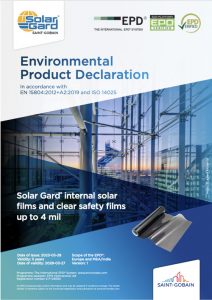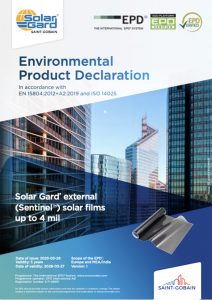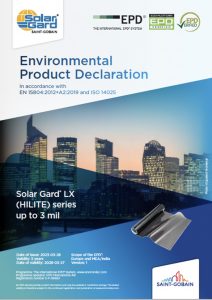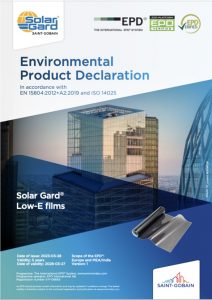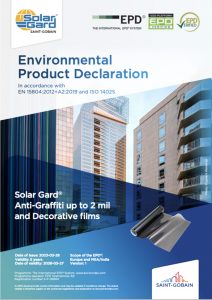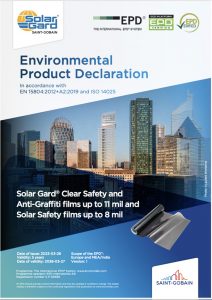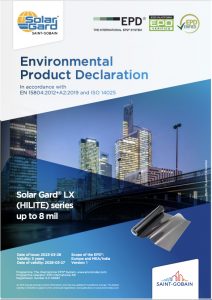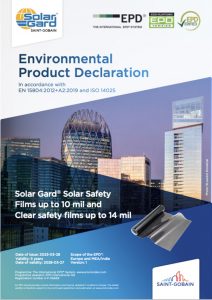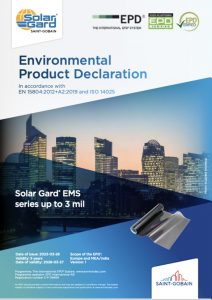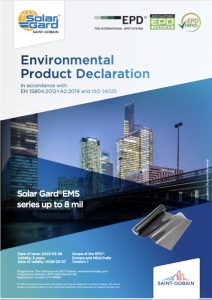Energy Efficiency & Sustainability
The EPD is based on a Life Cycle Assessment (LCA) of the cradle-to-grave impacts of Solar Gard’s products following the relevant international standards (ISO 14044 and ISO 14025) and have been third-party verified against the Product Category Rules (PCR) under program operator
The International EPD System®.For more information, visit
environdec.com/library
Search for “Solar Gard” and
you will find our 12 EPDs.
Saint-Gobain Solar Gard has achieved an EPD (Environmental Product Declaration) certification from
The International EPD System®, encompassing 92 architectural window film products, covering the architectural range of solar, and safety films, the range of Low-E films, films for both inside use and outside use (SENTINELTM) and for the decoration & design films. The Solar Gard Solar Control Window Films balance light transmission and heat rejection, helping to reduce energy consumption and improve both summer and winter comfort.Solar Gard Safety and Security films reduce the risk for damage and injuries in the case of breaking glass and give increased protection in case of impact or an explosion or in the case of an attempted intrusion.
Solar Gard window film reflects significant solar energy, while absorbing another portion of the energy. The result is that the amount of solar radiation transmitted inside the room is considerably less. Specs will vary depending on the Solar Gard window film selected.
Only a few degrees in temperature reduction can have up to a 25% reduction in cooling costs, due to the laws of thermodynamics. It requires considerable amounts of energy to remove heat from a room through air conditioning. During peak summer times in the middle of the day, loads on air conditioning systems can be reduced enough to turn off entire units or to install a less costly system.
In addition to the energy saving benefits, solar window film can increase thermal comfort, reduce glare, while at the same time rejecting 99% of the UV radiation reducing fading and the risk of skin cancer.

LEARN MORE
SOLAR GARD WINDOW FILM
A Sustainable Solution to Improving
Building Energy Efficiency
Compared to replacing windows, the embodied carbon of Solar Gard films is at least 30 times less than new windows. In addition to saving energy, Solar Gard’s architectural solar control window films are proven to be carbon negative and have a net positive environmental impact worldwide.
Because buildings are such a large source of carbon emissions, many building managers and home owners are concerned with reducing their carbon footprint.
In many cases, Solar Gard solar control window films are carbon neutral within one month of installation. Solar Gard window films are both carbon-effective and cost-effective, reducing a building’s carbon footprint more effectively and for less money than new windows and low-e coatings.
The Solar Gard® Window Films protect against solar heat and help to reduce the risks in case of glass breakage. The Solar Control Window Films can help to reduce the operational costs and carbon footprint of buildings.
Whether your goal is to reduce operating costs, decrease carbon emissions or create a more comfortable and productive environment, understanding your options is critical.
Your buildings’ windows offer one of the best opportunities for a solid return on investment for energy savings. Solar energy enters through windows and causes heat to build up inside the building, leading to uncomfortable hotspots and an increased need for air conditioning.
With proven heat-rejection properties, Solar Gard architectural solar controlwindow films can help your home or business consume up to 30%¹ less energy for cooling, by keeping interior temperatures more stable. This reduces the need for air conditioning while moderating peak usage and allowing yourcooling system to operate more efficiently.

